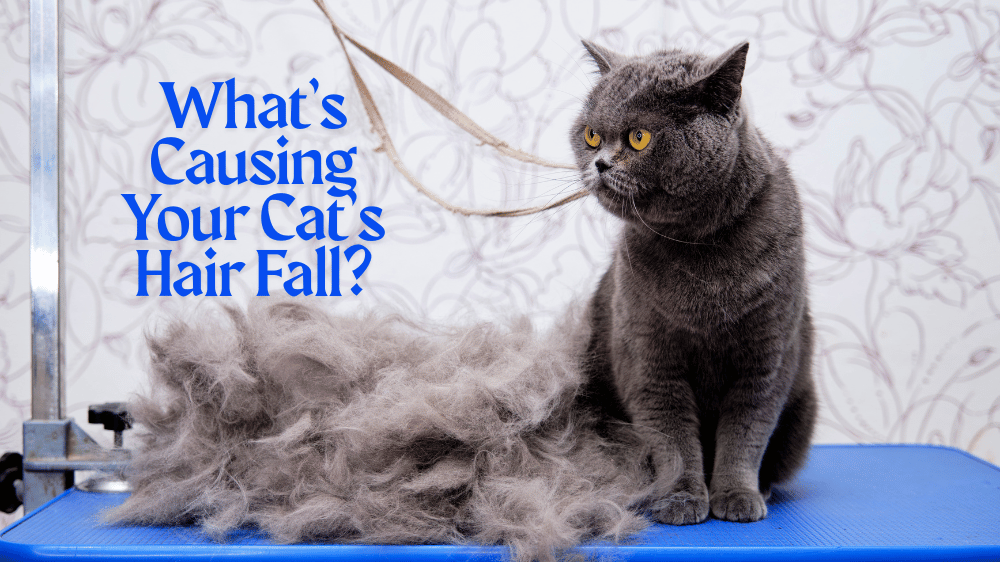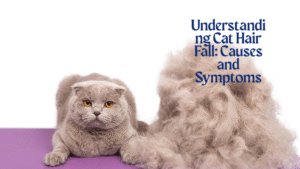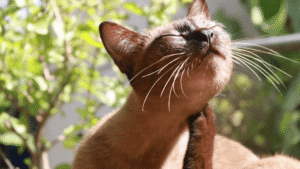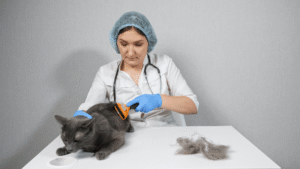While “cat hair fall” is something many cat parents deal with, once your feline friend is exhibiting more than normal shedding, it is important to understand why. Although all cats shed, excessive cat hair fall is a symptom of illness.
This article will help you understand that there are multiple reasons for the hair loss of your cat, and you can prevent them to maintain a nice and healthy coat for your beloved pet.
Understanding Cat Hair Fall: Causes and Symptoms
Before diving into the possible causes of “cat hair fall” causes, it’s essential to distinguish between normal shedding and problematic cat hair loss. Normal shedding is a natural process where cats lose old or damaged hair to make way for new growth.
However, excessive cat hair fall is different and can be a sign of underlying health issues. If your cat starts showing bald patches, thinning fur, or an unusual amount of hair around your home, it’s time to explore the possible causes of cat hair fall.
Normal Shedding vs. Excessive Cat Hair Fall
Normal shedding happens gradually and is usually in sync with the seasonal changes, where cats shed more in the spring and fall. Excessive cat hair fall, on the other hand, often presents itself as noticeable bald spots, thinning fur, or an increase in the amount of hair found on your furniture or clothing.
It’s important to monitor if your cat’s shedding is also accompanied by other symptoms, such as redness, inflammation, or excessive grooming. This could point to stress-related hair fall in cats or an allergy.
Common Signs to Look For
- Bald patches: Areas where fur is missing, especially around the ears, paws, or belly, are often caused by cat skin infections and hair loss or parasites.
- Thinning fur: This can indicate cat fur thinning reasons, including nutritional deficiencies or underlying health issues like hormonal imbalances.
- Behavioral changes: If your cat starts scratching excessively, licking, or even biting its skin, this could signal overgrooming in cats. This often happens due to discomfort, stress, or underlying health conditions, resulting in cat hair fall.
Why Persian Cats Are More Prone to Cat Hair Fall
Long-haired breeds like Persian cats are more susceptible to “cat hair fall” due to their dense, thick coats. These cats require regular grooming to prevent tangles and mats, which can cause hair loss if left unattended.
Persian cats need extra attention in their cat hair care and prevention routine to ensure their coat remains healthy and prevent excessive shedding. Without proper grooming, mats and tangles can contribute to cat hair fall, making regular brushing and care essential.
Key Related Factors to Consider:
- Cat hair fall due to parasites: Fleas and mites are the most common parasites that irritate your cat’s skin therefore your cat will scratch too much and it will cause hair fall. If not treated correctly, they can create bald spots and even some pain.
- Cat allergies and hair loss: Cat allergies and hair loss deserves a special mention here as allergies, be it food or environmental ones can provoke itching and rubbing causing hair loss in cats. Hypoallergenic shampoos and conditioners as well as changing your dog’s diet may assist in controlling these allergies.
- Signs of hair loss in cats: If you notice your cat losing more hair than the usual molting process, bald patches developing, or the cat showing signs of excessive grooming, be on alert. These usual signs are the signs of a cat hair fall problem, which could be caused by stress, infection, or an underlying issue.
Treating Cat Hair Fall
When cat hair fall gets out of control, you have to do something about it. There are a variety of treatments for cat hair loss, depending on what is behind the condition. For example:
- Cat hair fall due to parasites can be managed through flea preventatives and combing with a flea comb.
- It is possible for you to have to change his diet and coat products or the answer is a mild shampoo or conditioner.
- Stress-induced cat hair loss can be addressed by stress reduction in the form of interactive play, a peaceful environment, and grooming routine.
Common Causes of Cat Hair Fall
Knowing the cause of your “cat hair fall” will help you to safely solve any underlying problems and to treat your kitty. Here are a few common cat hair loss causes and what you can do to try and prevent the causes:
1. Parasites: Fleas, Mites, and More
Fleas and mites are also common causes of ‘cat hair fall’. These small nuisances irritate your cat’s skin, so they scratch, lick, or bitten themselves too much which makes them lose their hair.
In fact, the constant scratching could lead to open wounds and skin problems which could exacerbate the cat hair fall problem.
Prevention Tips:
- A good idea is to treat your cat regularly with an anti-flea and anti-mite product, especially if it gets outside.
- Make sure your Persian cat coat care routine involves regular grooming sessions to keep an eye out for parasites and minimize irritation.
- If you see other signs of infestation, such as itching, redness, or little dark grains in the fur, take your cat to the vet for suitable medication.
2. Allergies and Sensitivities
Cats can suffer from allergies to their food, the environment, and even their grooming products, just like humans. These allergies may cause skin irritation that induces “cat hair fall”.
Causes of feline hair fall symptoms like allergies can lead to compulsive scratching, itching, and cat fur thinning. Persian cats have triple-layered coats that make them susceptible to allergies, consequently, hair loss and bald patches.
Managing Cat Hair Care and Prevention:
- Switch to hypoallergenic grooming products that are free from harsh chemicals and fragrances.
- Identify and avoid the allergen – which might be a particular food additive, dust, pollen etc.
- Consult your veterinarian about hypoallergenic food choices and possible allergy treatments for your cat.
3. Skin Infections and Fungal Issues
Bacterial as well as fungal infection is one the most common culprit of cat hair fall. These infections are known to harm the skin of cats, leading to cat hair loss and bacterial or fungal symptoms such as scaly patches, redness, and unpleasant smells.
A fungal infection, such as ringworm, can cause bald patches in a ring formation. If these infection is not treated, then it results into aggravated infection ultimately leading to some serious consequences on the skin.
Recommended Persian Cat Bathing Tips and Hygiene Habits:
- Wash your cat, once a month, follow Persian cat bathing tips so not to allow dirt, oils and bacteria to buildup on your cats skin.
- Treat infections with antifungal or antibacterial shampoos recommended by your vet.
- Keep your cat’s bedding and grooming equipment clean to avoid reinfection.
4. Hormonal Imbalances in Cats
Hormonal disorders like hyperthyroidism, Cushing’s disease, can upset the way your cat’s body works and cause “cat hair fall”. These problems could lead to visible cat fur thinning reasons and behavioral changes, as they may feel more thirsty and hungry. Cats with hormone imbalances are also likely to have differences in their coat quality and texture.
Need for Vet Treatment for Cat Hair Loss:
- If you observe unexplained cat hair fall accompanied by other symptoms such as weight loss or excessive hunger, it is important to consult a veterinarian.
- A vet treatment for cat hair loss will diagnose if your cat has a hormonal imbalance and if appropriate, treat them.
- Your vet may treat your cat with medications or through other intervention, however, as part of your Persian cat grooming routine to promote good overall coat health.
5. Overgrooming or Stress-Induced Hair Fall
Excessive grooming in cats is a well-known problem, especially in long-haired cats such as Persian cats. Often, a stressed out, bored or anxious cat will engage in over-grooming, what is known as stress related hair fall in cats.
Overgrooming often can cause hair loss, usually in patches. This syndrome, called psychogenic alopecia, is fairly widespread in emotionally troubled cats.
Solutions for Cat Hair Care and Prevention:
- Create a serene and enriching environment to minimise any anxiety or overgrooming in cats.
- Play with your cat interactively every day and give him toys to keep him busy.
- Include regular brushing in your daily Persian cat grooming checklist to cut down on the temptation to over groom your feline and keep the coat healthy.
6. Poor Nutrition and Diet
Poor diet can also influence your cat’s skin and coat health which, results in cat hair fall. If your cat’s diet lacks the right nutrients, their coat may become dry, brittle, or may shed more than it should. Cats need vitamins and fatty acids in order to keep their skin healthy and their coats shiny.
Best Comb for Persian Cats and Dietary Supplements for Healthy Fur Growth:
- Be sure your cat is being fed a balanced premium-quality diet with sufficient protein and fat to nourish and protect her beautiful coat.
- Use grooming equipment such as specialized brushes to groom their long fur and remove any dead hair.
- Add a supplement to the diet: try a high-quality omega-3 fatty acid product for healthy fur growth to help with your cat hair care and prevention.
| Cause | Symptoms | Prevention/Treatment |
| Parasites (Fleas, Mites) |
Itching, bald patches |
Regular flea treatment, brushing with a flea comb |
| Allergies |
Red, inflamed skin, itching |
Identify allergens, use hypoallergenic grooming products |
| Skin Infections |
Redness, scabs, foul odor |
Use medicated shampoos, regular bathing, and hygiene maintenance |
| Hormonal Imbalances |
Fur thinning, lethargy |
Vet consultation for diagnosis and hormone treatment |
| Overgrooming/Stress |
Bald patches, hair thinning |
Stress reduction, regular brushing, and interactive play sessions |
| Poor Nutrition |
Brittle fur, hair loss |
Balanced diet with essential fatty acids, protein, and vitamins |
Effective Persian Cat Grooming Tips for Healthy Fur
Regular grooming is important for baby grooming and prevention of “cat hair fall”, this is especially for cats with long hair such as Persian cats.
Grooming your pet can help to reduce “cat hair” shedding, prevent tangles and your cat will feel cooler and more comfortable. Here are some useful advice on how to maintain your Persian cat’s coat in good condition and minimize excessive hair loss:
1. Persian Cat Brushing Techniques: How to Properly Brush to Prevent Tangles and Mats
Regular brushing is key to that beautiful, sleek coat, and keeping cat hair fall to a minimum. Their long hair is subject to tangles and matting, which can be uncomfortable and result in cat hair fall or skin irritation. Begin with a wide-toothed comb to carefully ease out any tangles, then use a fine-toothed comb to neaten the coat.
Regular brushing (at least 3-4 times a week) of your Persian cat will tear the loose hair from their skin which will help stop shedding, as well as helping to stop any mats from forming which can make things look like cat fur thinning.
Additional Tips:
- Instead, check out how to take care of Persian cats’ fur – brushing in the direction of hair growth, the hairs should be combed from the roots to the tips – in order to get rid of the loose hairs and untangled coat.
- Regular grooming also enables you to catch signs of parasites responsible for cat hair fall or skin issues early.
2. Best Grooming Products for Persian Cats: Must-Have Tools for Healthy Coat Care
For managing your Persian cat’s hair and avoid matting cat hair lies in the kind of grooming tools expended to keep the Persian cat’s coat looking shiny and thick.
A slicker brush is great for detangling and loosening hair, and a deshedding tool can mitigate shedding and keep extra hair from raining down in your home.
Moreover, a flea comb is a must in order to avoid having a flea infestation and eventually “cat hair fall” and you need a nail cutter, which is made for cats, to keep their claws short.
Must-Have Grooming Tools:
- Slicker Brush: Removes tangles and mats and decreases the cat hair shedding.
- Deshedding tool: Allows you to remove a lot of loose hair and reduces the amount of hair left on the furniture.
- Flea comb: Helps avert flea infestations, which can cause itching, and cat skin infections and hair loss.
3. How to Trim Persian Cat Nails: A Step-by-Step Guide
Regular nail trimming for your Persian is an integral part of maintaining your cat’s overall health and wellbeing. Long nails may cause harm to your cat’s skin or even pain when walking. Here’s how to safely trim your cat’s nails:
1.Softly take your cat’s paw and push on the pad to elongate the claws.
2.Trim only the very tip of the nail using a cat-only nail clipper, being careful not to cut into the pink area (referred to as the “quick”).
3.If your cat is nervous, give him a quiet, peaceful place to go, and reward good behavior to make the whole process less stressful.
4.Keep trimming a little at a time, and be careful not to cut yourself!
Regular nail trimming risks of injury and discomfort are avoided and if untreated, these can cause stress-induced hair fall in cats.
4. Creating a Regular Grooming Routine for Your Persian Cat: Tips for Maintaining a Consistent Schedule to Reduce Hair Fall
Frequent and regular grooming are key for cat hair care and prevention and this is especially true in the case of Persian cats. Frequent Grooming also directly helps in controlling cat hair fall and preventing over shedding and spotting potential health problems soon enough.
If you stick to a grooming schedule, you can catch issues like “cat skin infections and hair loss” or mats before they become problems. Here’s how you can work toward a robust routine:
1.Keep your cat’s coat free of loose hair and help prevent hairballs by brushing 3-4 times each week.
2.Bathing: Depending on the grooming requirements of your cat, bathe them using Persian cat bathing technique every 4-6 weeks to retain good skin health and to avoid cat hair shedding.
3.Prevent the discomforts that torn nails bring along with the pain.
4.Look out for parasites: Avoid any parasites that may lead into “cat hair fall” by using a flea comb.
So by maintaining a timely grooming routine, you not only can prevent any abnormal shedding or hair loss, but also help in decreasing the stress on your cat, thus averting the stress-related hair fall in cats.
When to Seek Veterinary Care for Your Cat’s Hair Fall
Why Early Diagnosis is Crucial:
Early intervention is key to preventing the worsening of conditions that cause “cat hair fall”. If you notice your cat losing hair excessively, it could be an indication of an underlying health problem like an infection, hormonal imbalance, or parasites.
Delaying treatment can lead to more severe issues, and in some cases, it can even result in permanent damage to your cat’s skin or coat.
Signs It’s Time to Visit the Vet:
- Continuous hair loss: If your cat is losing more fur than usual, especially in patches, it’s a good idea to consult a vet.
- Behavioral changes: Excessive grooming, biting at the skin, or becoming more withdrawn can signal that something is wrong.
- Skin issues: Redness, scabs, inflammation, or foul odors coming from your cat’s skin are red flags that require a vet’s attention.
Conclusion
To keep your Persian cat’s coat healthy and prevent “cat hair fall”, it’s essential to understand the causes and take action early. Regular grooming, a balanced diet, and proper care can make a significant difference in maintaining your cat’s fur health. Pay attention to any changes in your cat’s coat and behavior, and don’t hesitate to consult a veterinarian if you notice anything unusual.
If your cat is showing signs of excessive hair loss, it’s always best to schedule a visit to the vet. Early treatment will help your cat maintain a healthy coat and overall well-being. Also, ensure you’re following a consistent grooming routine to keep your feline friend looking their best.
FAQs
1. How can I prevent my cat’s hair from falling out?
To prevent cat hair fall, ensure your cat has a balanced diet rich in essential nutrients, regular grooming, and flea prevention treatments. Regular brushing helps to prevent tangles and mats, which can lead to cat hair shedding and hair loss. Keeping your cat stress-free and using the right grooming products are also key to maintaining a healthy coat.
2. What’s the best way to groom a Persian cat to avoid hair fall?
To avoid cat hair fall, use a slicker brush and a fine-toothed comb to groom your Persian cat regularly. Bathing your cat using appropriate Persian cat bathing tips will help maintain their coat, keeping it smooth and healthy.
Additionally, using high-quality grooming products specifically designed for Persian cats will help prevent matting and excessive shedding, both of which can contribute to cat hair loss.
3. Is it normal for Persian cats to lose a lot of hair?
Normal shedding is common in Persian cats, especially during seasonal changes. However, if your Persian cat is losing significant amounts of hair, developing bald patches, or showing other signs like itching or inflammation.
It may indicate an underlying issue such as cat skin infections and hair loss or “stress-related hair fall in cats. It’s essential to monitor your cat for other symptoms and consult a vet if necessary.
4. Can stress cause hair fall in cats?
Yes, stress can lead to overgrooming in cats, which is a common cause of stress-related hair fall in cats. When cats feel stressed or anxious, they may groom excessively, resulting in hair loss in certain areas. To reduce cat h
air fall due to stress, ensure your cat has a calm and enriching environment, and engage them in regular play and exercise.
5. How often should I bathe my Persian cat to prevent hair fall?
Persian cats should be bathed every 4-6 weeks, depending on their grooming needs and how well-maintained their coat is. Use gentle, cat-safe bathing products that are specifically designed for long-haired breeds.
After bathing, always follow up with thorough brushing to prevent tangles and mats, which can lead to cat hair shedding and hair loss.







